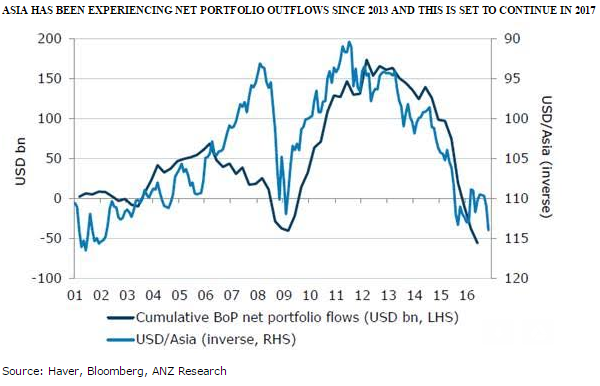Asian currencies are expected to depreciate for the fifth straight year, going into 2017, following mounting global headwinds; also sharp appreciation in the greenback will pose serious threats to major Asian currencies.
Rising US interest rates on the back of continued policy normalization by the US Federal Reserve and prospects of fiscal stimulus from a Trump administration is set to keep the USD bid. Asian economic growth should eventually benefit from a better performing US economy. But a stronger USD and rising US yield environment tends to cause volatility in capital flows and pose a headwind to Asian currencies.
Further, there remain potential risks from a rise in the Chinese yuan, although Chinese authorities have put up efforts to keep the RMB index stable. According to the report, ANZ remains bearish on both KRW as well as SGD. The real effective exchange rates of both currencies are elevated given the state of their economic cycles. A re-centring of the policy band by MAS is likely in 2017.
INR’s and IDR’s macroeconomic fundamentals have improved such that they are less vulnerable to rising US yields compared to the taper tantrum period. But with both countries running higher inflation rates compared to their trading partners, some nominal currency weakness can be expected, though this is compensated by their higher yield.



 Asian Currencies Slip as Dollar Strengthens; Indian Rupee Rebounds on Intervention Hopes
Asian Currencies Slip as Dollar Strengthens; Indian Rupee Rebounds on Intervention Hopes  Korea Zinc to Build $7.4 Billion Critical Minerals Refinery in Tennessee With U.S. Government Backing
Korea Zinc to Build $7.4 Billion Critical Minerals Refinery in Tennessee With U.S. Government Backing  U.S. Dollar Slips Near Two-Month Low as Markets Await Key Jobs Data and Central Bank Decisions
U.S. Dollar Slips Near Two-Month Low as Markets Await Key Jobs Data and Central Bank Decisions  Oil Prices Slip in Asia as 2026 Supply Glut Fears and Russia-Ukraine Talks Weigh on Markets
Oil Prices Slip in Asia as 2026 Supply Glut Fears and Russia-Ukraine Talks Weigh on Markets  Oil Prices Rebound as U.S.-Venezuela Tensions Offset Oversupply Concerns
Oil Prices Rebound as U.S.-Venezuela Tensions Offset Oversupply Concerns  Gold Prices Fall Amid Rate Jitters; Copper Steady as China Stimulus Eyed
Gold Prices Fall Amid Rate Jitters; Copper Steady as China Stimulus Eyed  Asian Stocks Slide as AI Valuation Fears and BOJ Uncertainty Weigh on Markets
Asian Stocks Slide as AI Valuation Fears and BOJ Uncertainty Weigh on Markets  Bank of Korea Downplays Liquidity’s Role in Weak Won and Housing Price Surge
Bank of Korea Downplays Liquidity’s Role in Weak Won and Housing Price Surge  Asian Technology and Chipmaking Stocks Slide as AI Spending Concerns Shake Markets
Asian Technology and Chipmaking Stocks Slide as AI Spending Concerns Shake Markets  Asian Fund Managers Turn More Optimistic on Growth but Curb Equity Return Expectations: BofA Survey
Asian Fund Managers Turn More Optimistic on Growth but Curb Equity Return Expectations: BofA Survey  Asian Stocks Slide as Central Bank Decisions and Key Data Keep Investors Cautious
Asian Stocks Slide as Central Bank Decisions and Key Data Keep Investors Cautious  South Korea Warns Weak Won Could Push Inflation Higher in 2025
South Korea Warns Weak Won Could Push Inflation Higher in 2025  Dollar Struggles as Markets Eye Key Central Bank Decisions and Global Rate Outlooks
Dollar Struggles as Markets Eye Key Central Bank Decisions and Global Rate Outlooks  Gold and Silver Prices Dip as Markets Await Key U.S. Economic Data
Gold and Silver Prices Dip as Markets Await Key U.S. Economic Data 































